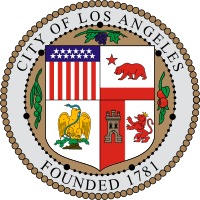Picfair Village, Los Angeles
Picfair Village is a residential district in the Westside of the city of Los Angeles, California. 'Picfair' refers to the northwest corner of Pico and Fairfax, site of the former Picfair Theater.
Geography
Picfair Village's boundaries are Pico Boulevard on the north, Hauser Boulevard on the east, Venice Boulevard on the south, and Fairfax Avenue on the west. Picfair Village is part of the P.I.C.O. Neighborhood Council. The Wilshire Vista district lies to the north, as does the Miracle Mile area in the Mid-Wilshire and/or Mid-City West regions where LACMA and the La Brea Tar Pits are located, The Little Ethiopia district lies to the northwest and the Crestview neighborhood to the west where KROQ-FM, LAWPD Receiving Station # D, Electric Charging Station, Pepper Claude Senior Center, La Cienega Plaza Shopping Center, Reynier Park, Rocha House, Crescent Heights Boulevard Elementary School, Shenendoah Street Elementary School, Kaiser Permanente and the magnet school, Los Angeles Center for Enriched Studies are located, Lafayette Square in the Mid-City region where the LAWPD manager building is located to the south and Pico Park in the Mid-Wilshire region to the east. Primary thoroughfares through the area include Pico Boulevard, Venice Boulevard, Fairfax Avenue, and Airdrome, Pickford, Saturn and 18th Streets.
Neighborhood composition and demographics
Picfair Village is primarily a middle-income area with a moderate African-American majority. Per the U.S. Census of 2000, racial representation is approximately 50% African-American, 20% non-Latino white, 25% Latino of any race, and 5% Asian/Pacific Islander. Median household income is in the area of $45,000. The housing stock is predominantly Spanish Colonial and Art Deco one- and two-family homes (the neighborhood is zoned R-1 & R-2), with some multi-unit dwellings (mostly in the areas north of Saturn Street). The latter tend to be Mid-Century architecture. The main street of the "Village" is Pico Boulevard between Fairfax and Hauser, and is dotted to with trendier cafes, restaurants and boutiques, owing to the area's growing popularity and reasonable commercial lease rates.
In November 2004, Picfair Village was named as one of Los Angeles magazine's "10 Most Overlooked Neighborhoods in Los Angeles."
In January, 2007, the Los Angeles Times said Picfair Village is "on its way to becoming L.A.'s next trendy place to live and play."[1]
As mentioned earlier, the area just south of Pico, but north of Saturn Street, has a mix of homes and 2 and 4 plexes. South of Pickford, you will find it is mostly single family residential homes. Another interesting feature of this neighborhood: The homes on the North/South Street tend to be all full size lots (5,000 - 6000 sq. ft.), while homes on the east/west streets tend to be bungalow (smaller) size lots."
History
Picfair Village takes its name from the majestic Picfair movie theatre which stood at the corner of Pico and Fairfax until the early 1980s.
Initially hailed as "the New Wilshire...[and] a delightful place for a home," what is now Picfair Village was part of the Santa Monica Land and Water Co.'s 1922 development called Pico Boulevard Heights. Their tract office was located on the Pico street car line at Fairfax and Pico. They offered "choice lots on Genesee Street" starting at $1,250.
What is now Picfair Village was once home to the author Walter Mosley for a while, and one of his characters lived on Stanley. The neighborhood has been active since 1998 when it was first named the Pico Fairfax Neighborhood Association. At one of the early meetings, the group voted to change the name to the Picfair Village Community Association.

